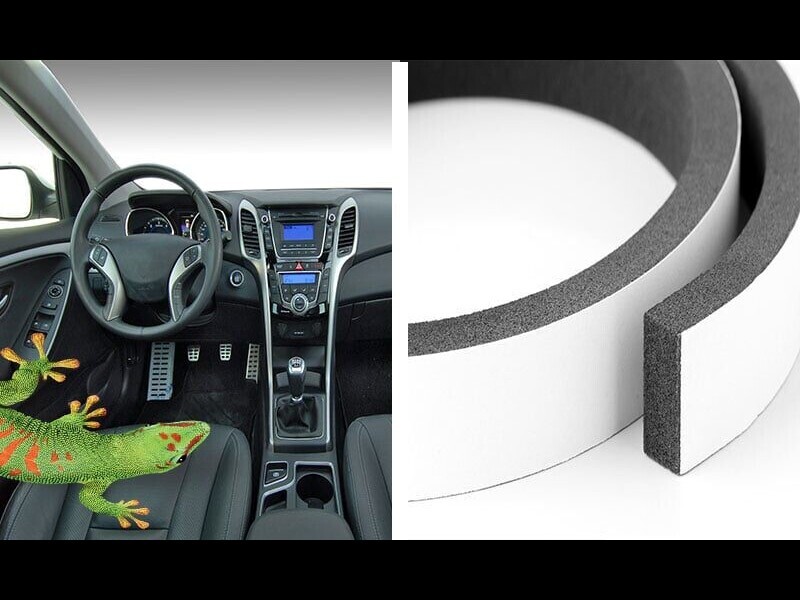
More automotive manufacturers are looking to include sound damping tape in their vehicles due to its ability to address key consumer trends. Sound damping tape, also referred to as sound deadening, vibration damping and noise, vibration and harshness tape, has seen increased use in recent years for improving vehicles overall. Therefore, it’s a good idea to learn more about this application and why you should offer these tapes in your portfolio.
How is sound damping tape used in vehicles?
Improving driver safety
As mentioned in our latest post on sound damping tapes, certain vehicle trends, like electric vehicles (EVs), can cause more noise to enter the vehicle than traditional engines. Without a traditional engine to drown out sounds from the road and mechanical components, this extra noise can distract the driver from necessary traffic signals. This creates a safety issue for the riders.
Fortunately, sound damping tape helps diminish the extra noise in EVs. The foam backing or core of the tape makes it excellent at diffusing sound waves. Using the tape to cushion trim, knobs and other small components from road vibrations will prevent external noise from entering the cabin. A quieter ride means the driver will be able to concentrate on driving and not the noisiness of the vehicle.
Enhancing comfort and aesthetics
In luxury vehicles, consumers have higher expectations for comfort. Luxury vehicle brands use sound damping tape to create a soothing, quiet experience for the passengers without compromising on stylistic elements.
Sound damping tape reduces road noise, enhancing the ambiance inside the vehicle. Because the tape can be applied to components that aren’t visible to the passengers, the sleek designs of a luxury vehicle interior don’t need to be modified to include sound absorbing equipment. The tape can be applied in discreet places including:
- HVAC systems
- Floor and door insulation
- Mounting brackets
- Brakes
- Dashboard components
- Roof lining
- Window seals
Reducing wear and tear
Certain vehicular components experience routine vibrations that degrade material over time. Doors and hatches that are frequently slammed shut may become damaged as the vehicle ages. Some mechanical components may vibrate against each other, causing slow degradation. Additionally, impacts from gravel roads and potholes can contribute to the wearing down of various components.
Sound damping tape can help reduce routine wear and tear. The tape doesn’t just help reduce noise; it also helps absorb vibrations. The foam backing on the tape can help reduce the impact from potholes, rough roads, slamming doors and other friction that can wear down vehicular components over time. Or, when a substrate on one side of the tape is vibrating, sound damping tape can diffuse the vibrations rather than passing them on to the substrate on the opposite side. Finally, the tape can also help reduce vibration on stylistic elements like hood emblems, glovebox drawers or console lids. This will help ensure the visual aesthetics of the vehicle won’t be damaged by vibration.
Increasing structural bond strength
Modern vehicles have introduced new automotive materials, including lightweight aluminum and plastic substrates. While these materials offer advantages like fuel efficiency, they can be hard to adhere. Metal fasteners can be used for structural bonding, but they cannot bend or “give” to allow for thermal expansion or stretching on various substrates. This may cause the fastener to break. Metal fasteners are also heavy, adding weight back into the vehicle.
In addition to noise and vibration reduction, the adhesive properties of sound damping tape offer structural benefits to a vehicle’s components. The foam backing flexes and “gives” to accommodate changes to the fit of two surfaces. This is advantageous for substrates that exhibit differing thermal expansion properties or stretching. Sound damping tape also provides structural bond strength and high adhesion to replace mechanical fasteners with an even bond across the full contact area of two substrates. Further, many tapes can now bond to low surface energy substrates like plastic and aluminum, making it easier to use new materials in a vehicle.
Why Should You Use Bostik Adhesives In Your Sound Damping Tape?
Sound damping tape has many different purposes in the automotive industry. By adding it to your product line, you can expand your customer base and show you understand the needs of automotive manufacturers. You’ll be able to help automotive manufacturers address key issues in tomorrow’s vehicles today.
Bostik offers several adhesive solutions that are compatible with a variety of backings and substrates to help you create reliable sound damping tape. Contact a Bostik representative today to learn more about our tape adhesive solutions.
Learn more with this other relevant content:
